2. The Early Years: 1946-1950
1
During the first five years of operation, H&D league rosters contained a number of local players who easily held their own against the growing number of imported ballplayers who were attracted to Nova Scotia by the level of play and reasonably competitive salaries. Condy, Clark, Ferguson, the Seamans, Clyde and Sid Roy, Harry Reekie, Wilf Anderson, Eddie Gillis, Leo Fahey, Bev Buckler, Gordon Troke, Joe Cormier, Bill Marsh, Harris Young, Mac Bowers, Joe Breen, "Twit" Clarke, "Red" Burchell, Dev Vickers, Neil Staples, Stan Cann, Lloyd Young, Howie Martin, Tommy "Mountain Boy" Linkletter, Jackie Rudderham, Win Langille, Leo Woods, and Jimmy Gray were just a handful of the talented locals who played and often starred on the diamond in these years.
2
Neil Staples, a local player, of the Dartmouth Arrows
1948
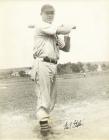
3
Team photograph of the Halifax Capitals.
1948
Wanderers Grounds, Halifax, Nova Scotia
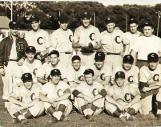
4
One souvenir program for a game.
1948

5
Opening day 1948
24 May 1948
'Little Brooklyn', Dartmouth Nova Scotia
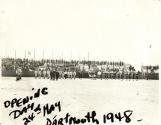
6
When the Brooklyn Junior Dodgers visited Nova Scotia in the summer of 1948 to take on a team of junior-age players it was the home-brews who led the local squad to a 3-1 victory. On the strength of Maritimer Joe Breen's towering home run the H&D league juniors bested the Dodgers, whose roster included eventual major leaguers, Billy Loes, Don McMahon and Joe Pignatano,. Nova Scotian"Twit" Clarke held the baby Dodgers to just four hits. A similar scene unfolded in a three game series in 1949 against the New York Equitable Life team, the National Baseball Congress Semi-pro champions in the United States in 1948 and 1949. Although the New Yorkers won the deciding match in extra innings, they were more than impressed with the quality of their opponents, especially locals Johnny Clark and "Red Burchell". According to New York first-baseman Fred Price his club came to Nova Scotia expecting to meet the equivalent of a Class C club, but found the game here "as good as anything being played in the Class A leagues in the United States."
7
League players give batting tips.
1949
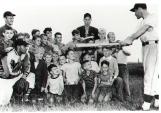
8
Dartmouth Arrows coach Dev Vickers argues a call with umpire Johnny Fortunato
1948
Wanderers Grounds, Halifax, Nova Scotia
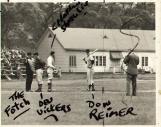
9
Buddy Condy of the Halifax Arrows gets safely back to first base
1947
Wanderers Grounds, Halifax, Nova Scotia
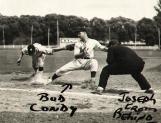
10
1948 Halifax and District All Stars
1948
Wanderers Grounds, Halifax, Nova Scotia
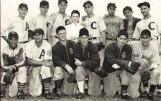
11
Season pass for Elliott Hudson
1948
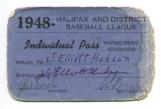
12
1947 Halifax and District All Stars
1947
Wanderers Grounds, Halifax, Nova Scotia
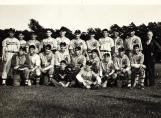
13
Even as late as 1950 there was still enough local talent to field a competitive team in the Rainbow Haven all-star game pitting imports against homebrews. The game, held before 5500 fans at Wanderer's Grounds in Halifax, was a tight one, which the imports won by a score of 5-4 despite having been held to five hits. By this time, however, the die was pretty well cast. As Skit Ferguson observed, the average player in the league gradually became an import rather than a local. "Many locals could've continued to play," Johnny Clark points out. "They may not have been stars, but many of those who were brought in from the States weren't stars either." Only the exceptional Maritime ballplayer would be given a chance to play in the H&D league after 1950.
14
Sidney Roy of Westville
1952
Albion Field, Stellarton, Nova Scotia

15
Already, however, the tensions between locals and imports were beginning to surface. When fire-balling pitcher Clyde Roy threw inside on Bobotas one afternoon, for example, Bobotas responded by calling him a "local punk". Boss dropped his glove, stormed the plate, picked Bobotas off the ground and slammed him flat on his back on home plate. After the game Boss approached Bev Buckler, one of Kentville's home-town players. "Bucky," he said, "I don't know why you continue playing with those bastards!"
The Central League Wildcats continued in a similar direction the following year with UNH baseball coach Hank Swasey at the helm. Kentville relied heavily upon players from the Northern League, including Bobotas, shortstop Johnny Watterson, outfielders Jack Kaiser (later chosen Varsity magazine's collegiate player of the year in 1949), Chris Tonery and Hal Burby. Swasey also worked closely with the Brooklyn Dodgers who arranged for pitcher Tom McMullen and veteran minor league catcher Paul O'Neill to join the club. The Dodgers also recommended hulking Temple University first-baseman Dick Gernert who would later play ten years in the major leagues, mostly in a Boston Red Sox uniform. The northern exodus grew as well because of a decision by the Eastern College Athletic Conference (ECAC) to declare the Northern League a professional league. Many of that league's players chose to come north rather than lose their collegiate eligibility.
16
Members of the Kentville Wildcats
1950
Kentville, Nova Scotia
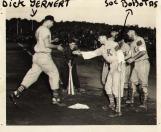
17
Composite photograph of the 1948 Kentville Wildcats
1948
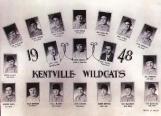
18
Len Boss, of Springhill, NS
1946

19
An increasing reliance on imports had actually begun in 1947. That year league president Harry Butler gave up his post as vice-president of the Nova Scotia Amateur Baseball Association to give "full attention to top quality ball for Halifax." Local sportswriter Alex Nickerson interpreted this to mean a high-priced circuit with an emphasis on imported players. He was right. The major sources of playing talent in the future would be the Northern League in Vermont and New Hampshire, the Albemarle League in the Carolinas, and college teams in both those areas as well as in Massachusetts, Connecticut, New York and Pennsylvania. The 1947 Kentville Wildcats, for example, signed 22 year old "Soc" Bobotas, from Manchester, New Hampshire, as playing coach. Accompanying Bobotas were a number of his teammates from the Northern League and the University of New Hampshire varsity. An exception was seventeen year old Art Ceccarelli, a left-handed pitcher from New Haven who would later play five seasons in the major leagues.
20
Group photo of the Halifax and District Baseball League umpire staff for 1950
1950
Wanderers Grounds, Halifax, Nova Scotia
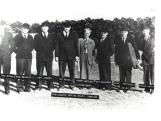
21
The success of the import-laden Wildcats in the Central league in 1947 and '48 had a ripple effect across the province. In 1948 Middleton Cardinals assembled a team largely made up of imported players from the Windsor-Detroit area, including veteran minor leaguers Buster Pankratz and Bernie Parent, youngsters Jim and John Wingo (sons of former major leaguer 'Red" Wingo) Frank Lerchen, Paul Bulger, Jack Graham, Nick Nikita and Jimmy Dumeah. Dumeah would settle permanently in Nova Scotia. Other imports on the club included Emmanuel "Sonny" Senerchia who was later signed and played with the Pittsburgh Pirates in 1952, and William 'Bucky" Tanner who had been blacklisted from major league baseball for jumping his contract and playing in the outlaw Mexican League in 1946. Tanner delighted fans by regularly appearing at the ball park in a wide-brimmed sombrero.
22
Bucky Tanner of the Middleton Cardinals.
1948

23
Four members of the Middleton cardinals stand in front of the dugout.
1948
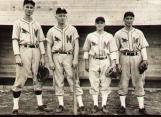
24
By 1949 many clubs were concentrating upon imported players. In Stellarton, manager Stuffy McInnis (once a member of the Philadelphia Athletics' famed $100,000 infield) had nine imports in tow to start the 1949 season. McInnis relied nonetheless upon local players Harry Reekie and John "Twit" Clarke, both of whom worked in the mines by day and played ball at night. "Stuffy, he couldn't get over it here in Stellarton," Clarke recalled. "He said 'I can't figure out how they do it. They work all day in the mines; they come up here; they have a shower and maybe grab a sandwich; and they play ball, and they play good ball'". McInnis was convinced that if Reekie would agree to go south with him that he had a good shot of making it all the way to the majors. But Reekie was happy playing in Stellarton along with friends like Sid Roy who won 25 games against only six losses in four years with the Albions.
25
Composite photograph of the 1950 Stellarton Albions.
1950
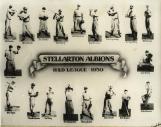
26
Two teams, the Halifax Shipyards and the Liverpool Larruppurs, bucked the trend and remained committed to local players. From the early days of the war and into the postwar years, Shipyards overlord R.J.R. Nelson had put together teams that drew heavily on local talent. In 1950 five local players, four of them members of the Shipyards, ranked in the top ten batters in the league. Condy led the league with a .358 batting average, followed closely by Johnny Clark at .350. "Red" Burchell stood in sixth spot in the batting race hitting .295 and Leo Woods was tenth at .285. On the mound the Yardmen were led by imports Jack Halpin with a 13 and 2 won-lost record and 2.44 ERA, and Frank Giaquinto at 8 and 1 and a 2.03 ERA. They were supported by locals 'Twit" Clark (5-3 and 1.66) and Len Boss (2-4 and 4.43).
27
Halifax Capital player slides safely into home plate.
1950
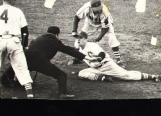
28
Bob Fitgerald of the Halifax Capitals and Halifax Shipyards runner Ted Narleski.
1950
Wanderers Grounds, Halifax, Nova Scotia

29
Jimmy Gray throws to first baseman Don Reimer
1948
Wanderers Grounds, Halifax, Nova Scotia

30
Buddy Condy of the Halifax Arrows gets safely back to first base
1947
Wanderers Grounds, Halifax, Nova Scotia

31
Across the harbour the Dartmouth Arrows went the import route. The Dartmouth club began operations in 1948 when two Halifax merchants, Herm and Bob Kaplan relocated the Halifax Arrows to play at newly constructed "Little Brooklyn", a park that equaled many AA class parks in seating capacity, and which like Ebbetts Field in Brooklyn had a short right field fence. In 1949 the Kaplans hired Bob Decker, a veteran minor leaguer in the Yankees chain, to put together the club with assistance from both the Yankees and the Chicago Cubs. The '49 Arrows had only one local player, Howie Martin, on its roster, but he played a significant role as the club won the provincial championship.
32
1950 Dartmouth Arrows Baseball Team, champions of the Halifax and District BAseball League
1950
'Little Brooklyn', Dartmouth Nova Scotia
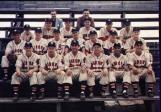
33
Dartmouth Arrows owner Herman Kaplan
1948
'Little Brooklyn', Dartmouth Nova Scotia

34
Dartmouth Arrows dugout at ballpark in Dartmouth know as Little Brooklyn
1950
'Little Brooklyn', Dartmouth Nova Scotia
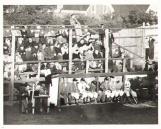
35
Jim Heller of the Dartmouth Arrows argues call with umpire.
1950
'Little Brooklyn', Dartmouth Nova Scotia
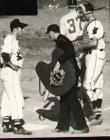
36
Members of the Dartmouth Arrows pose on the field of Little Brooklyn in Dartmouth
1950
'Little Brooklyn', Dartmouth Nova Scotia
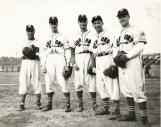
37
Among the imports on the club, two stand out: the first was Smokey Jim Heller a hard bitten pitcher from Texas, the second a young outfielder by the name of John "Zeke" Bella. An immensely talented youngster with speed, power and a good arm, Bella starred in 1949 and 1950, and after a few years of military service returned to win the H&D league batting championship in 1954. Chattel of the New York Yankees, he never hit below .300 in the minor leagues, and eventually broke into the majors with the talent-laden Yankees before being traded to the Kansas City Athletics in 1959. With the A's, Bella suffered a career shortening shoulder injury slamming into the wall while making a running catch. Perhaps the finest all-around player ever to play in Nova Scotia, Bella never fully realized his enormous potential.
38
Ray Clayton and Zeke Bella of the Dartmouth Arrows.
1949
Wanderers Grounds, Halifax, Nova Scotia
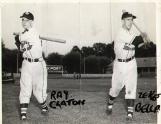
39
Zeke Bella in action
1949
'Little Brooklyn', Dartmouth Nova Scotia
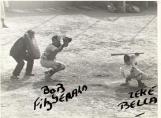
40
Another of Decker's protégés, Jim Heller had played against Decker in the West Texas League where he won twenty games in 1948 and would repeat the feat in 1951. A crafty moundsman Heller had a delivery that kept opposing hitters off balance. Heller delivered the ball "out of his pocket almost," Johnny Watterson remembers. "You just couldn't see it in time." Heller became an instant leader with the Arrows winning ten games in 1949 and nine the following year, and Decker always turned to him in tight spots. Led by Heller and Bella, and supported by shortstop Tommy Dulmage, outfielders Doc Acocella, Joe Lay, and others, the Arrows were the class of the H&D league in 1949 and 1950 They were league championship both years. It should be noted, however, that the Central league Kentville Wildcats of 1949 with Gernert, Kaiser, Bobotas, Watterson and Chris Tonery were probably as talented as any team of the era. As a new decade began, however, forces were at work that would shift the balance of power in the league northeast to Pictou County and the Stellarton Albions.
41
'Smokey' Jim Heller of the Dartmouth Arrows
1949
'Little Brooklyn', Dartmouth Nova Scotia

|






























